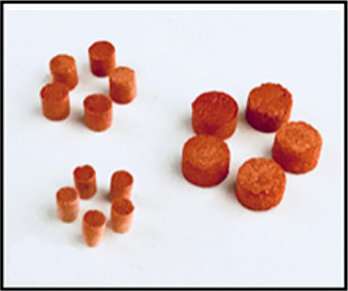A pill for delivering biomedical micromotors

Using tiny micromotors to diagnose and treat disease in the human body could soon be a reality. But keeping these devices intact as they travel through the body remains a hurdle. Now in a study appearing in ACS Nano, scientists report that they have found a way to encapsulate micromotors into pills. The pill's coating protects the devices as they traverse the digestive system prior to releasing their drug cargo.
About the width of a human hair, micromotors are self-propelled microscopic robots designed to perform a host of biomedical tasks. In previous research, Joseph Wang, Liangfang Zhang and colleagues used micromotors coated with an antibiotic to treat ulcers in laboratory mice. They found that this approach produced better results than just taking the drugs by themselves. However, the researchers noted that body fluids, such as gastric acid and intestinal fluids, can compromise the effectiveness of micromotors and trigger early release of their payloads. In addition, when taken orally in fluid, some of the micromotors can get trapped in the esophagus. To overcome these issues, Wang and Zhang sought to develop a way to protect and carry these devices into the stomach without compromising their mobility or effectiveness.
The researchers created a pill composed of a pair of sugars—lactose and maltose—that encapsulated tens of thousands of micromotors made of a magnesium/titanium dioxide core loaded with a fluorescent dye cargo. These sugars were chosen because they are easy to mold into tablet, can disintegrate when needed and are nontoxic. When given to laboratory mice, these pills improved the release and retention of the micromotors in the stomach compared to those encapsulated in silica-based tablets or in a liquid solution. The researchers concluded that encapsulating micromotors in traditional pill form improves their ability to deliver medicines to specific targets without diminishing their mobility or performance.
More information: Emil Karshalev et al, Micromotor Pills as a Dynamic Oral Delivery Platform, ACS Nano (2018). DOI: 10.1021/acsnano.8b03760
Abstract
Tremendous progress has been made during the past decade toward the design of nano/micromotors with high biocompatibility, multifunctionality, and efficient propulsion in biological fluids, which collectively have led to the initial investigation of in vivo biomedical applications of these synthetic motors. Despite these recent advances in micromotor designs and mechanistic research, significant effort is needed to develop appropriate formulations of micromotors to facilitate their in vivo administration and thus to better test their in vivo applicability. Herein, we present a micromotor pill and demonstrate its attractive use as a platform for in vivo oral delivery of active micromotors. The micromotor pill is comprised of active Mg-based micromotors dispersed uniformly in the pill matrix, containing inactive (lactose/maltose) excipients and other disintegration-aiding (cellulose/starch) additives. Our in vivo studies using a mouse model show that the micromotor pill platform effectively protects and carries the active micromotors to the stomach, enabling their release in a concentrated manner. The micromotor encapsulation and the inactive excipient materials have no effects on the motion of the released micromotors. The released cargo-loaded micromotors propel in gastric fluid, retaining the high-performance characteristics of in vitro micromotors while providing higher cargo retention onto the stomach lining compared to orally administrated free micromotors and passive microparticles. Furthermore, the micromotor pills and the loaded micromotors retain the same characteristics and propulsion behavior after extended storage in harsh conditions. These results illustrate that combining the advantages of traditional pills with the efficient movement of micromotors offer an appealing route for administrating micromotors for potential in vivo biomedical applications.
Journal information: ACS Nano
Provided by American Chemical Society




















